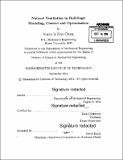| dc.contributor.advisor | Leon Glicksman. | en_US |
| dc.contributor.author | Ip Kiun Chong, Karine | en_US |
| dc.contributor.other | Massachusetts Institute of Technology. Department of Mechanical Engineering. | en_US |
| dc.date.accessioned | 2015-02-05T18:26:19Z | |
| dc.date.available | 2015-02-05T18:26:19Z | |
| dc.date.copyright | 2014 | en_US |
| dc.date.issued | 2014 | en_US |
| dc.identifier.uri | http://hdl.handle.net/1721.1/93829 | |
| dc.description | Thesis: S.M., Massachusetts Institute of Technology, Department of Mechanical Engineering, 2014. | en_US |
| dc.description | Cataloged from PDF version of thesis. | en_US |
| dc.description | Includes bibliographical references (pages 192-195). | en_US |
| dc.description.abstract | Natural ventilation in buildings has the potential to reduce the energy consumption usually associated with mechanical cooling while maintaining thermal comfort and air quality. It is important to know how building parameters, in particular its thermal mass properties and heat loads incurred, affect a building's transient thermal response to incoming outdoor air. A proper ventilation schedule is also needed to make optimal use of the free direct or night cooling. To investigate these factors, a first principles heat transfer energy model is developed to numerically simulate in MATLAB the air temperature profile of a single-zone cross-ventilated room. The physics behind natural ventilation at building level is also investigated using multi-zone modeling, as done in CoolVent, an existing MIT airflow modeling tool. In the process, the simulation capabilities of MIT Design Advisor, an existing building energy simulation tool, are expanded upon from shoe-box to interconnected multi-zone modeling. Optimal natural ventilation scheduling, with a view to maximizing thermal comfort, is then studied using two optimization techniques: dynamic programming and global search optimization, using the simple room energy model as the simulation engine. In the process, an algorithm framework is developed to optimize the ventilation scheduling on a rolling day-horizon basis based on input weather data and occupancy schedule. The use of rule-based control, as opposed to the aforementioned model-optimized control, is also explored due to its ease of implementation in building automation software. The former form of control is found to maintain comparable thermal comfort when separate rules for specific scenarios, such as night-overcooling or day-overheating, are gathered together to constrain the room air temperature. It is however critical to identify and calculate proper set-points for these rules. | en_US |
| dc.description.statementofresponsibility | by Karine Ip Kiun Chong. | en_US |
| dc.format.extent | 195 pages | en_US |
| dc.language.iso | eng | en_US |
| dc.publisher | Massachusetts Institute of Technology | en_US |
| dc.rights | M.I.T. theses are protected by copyright. They may be viewed from this source for any purpose, but reproduction or distribution in any format is prohibited without written permission. See provided URL for inquiries about permission. | en_US |
| dc.rights.uri | http://dspace.mit.edu/handle/1721.1/7582 | en_US |
| dc.subject | Mechanical Engineering. | en_US |
| dc.title | Natural ventilation in buildings : modeling, control and optimization | en_US |
| dc.type | Thesis | en_US |
| dc.description.degree | S.M. | en_US |
| dc.contributor.department | Massachusetts Institute of Technology. Department of Mechanical Engineering | |
| dc.identifier.oclc | 900651012 | en_US |
